3 dead, state capital battered as storms rake Missouri
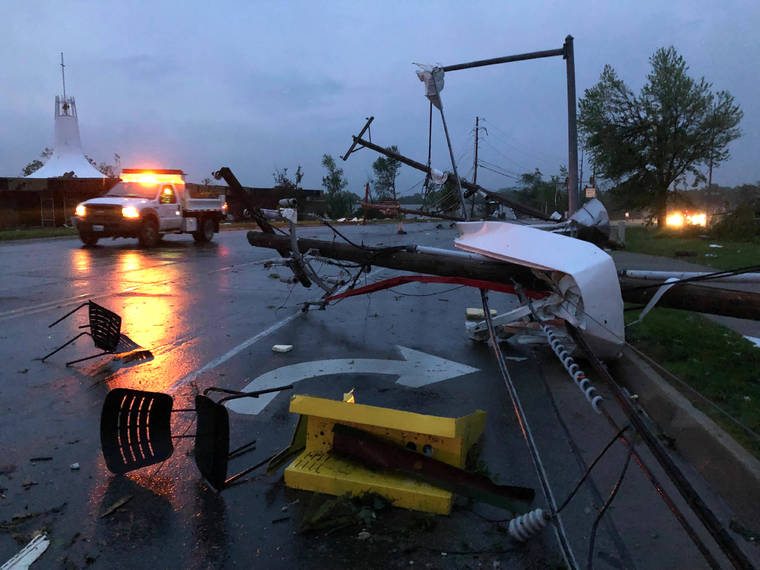
Plastic chairs lie in the road and metal from a damaged gas station roof is twisted around a downed power line in Jefferson City Missouri Thursday, May 23, 2019. The National Weather Service has confirmed a large and destructive tornado has touched down in Missouri’s state capital, causing heavy damage and trapping multiple people in the wreckage of their homes. (AP Photo/David A. Lieb)
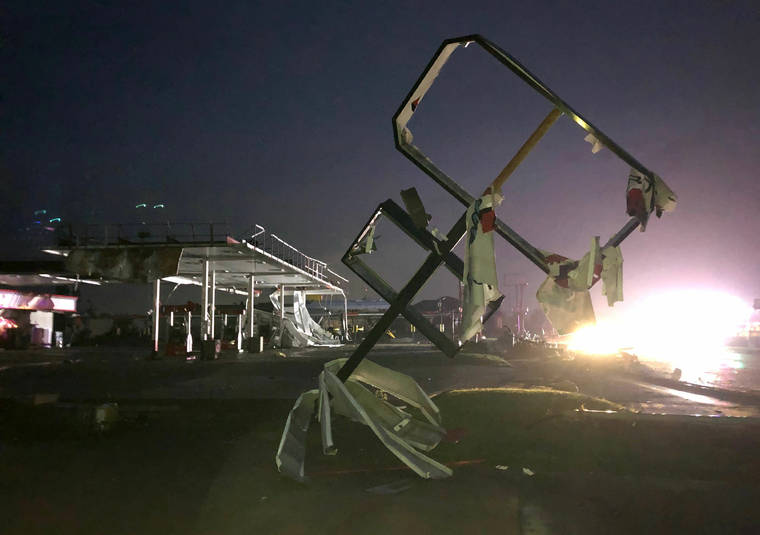
A destroyed sign for a car wash is seen in tornado-hit Jefferson City, MO., Thursday, May 23, 2019. The heavily damaged gas station is at background. The National Weather Service has confirmed a large and destructive tornado has touched down in Missouri’s state capital, causing heavy damage and trapping multiple people in the wreckage of their homes. (AP Photo/David A. Lieb)
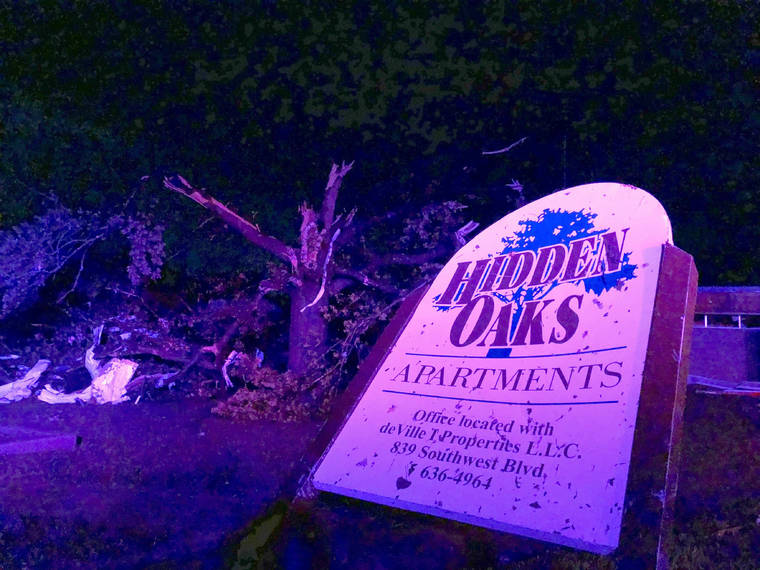
The sign for the Hidden Oaks apartment complex in Jefferson City Missouri stands bent on May 23, 2019, from an apparent tornado in front of a tree that was ripped apart. A “violent tornado” touched down in Jefferson City, Missouri, causing possible fatalities, according to the National Weather Service (AP Photo/David A. Lieb)
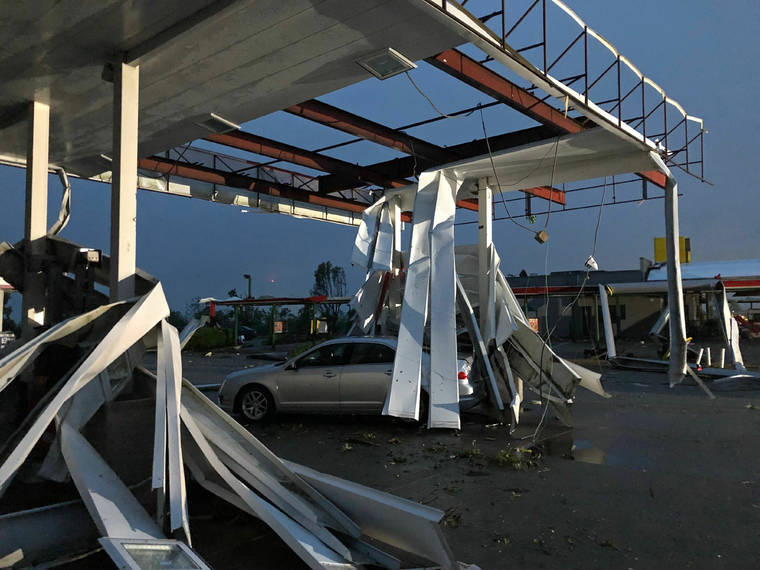
A car is trapped under the fallen metal roof of the Break Time gas station and convenience store in tornado-hit Jefferson City, MO., Thursday, May 23, 2019. The National Weather Service has confirmed a large and destructive tornado has touched down in Missouri’s state capital, causing heavy damage and trapping multiple people in the wreckage of their homes. (AP Photo/David A. Lieb)
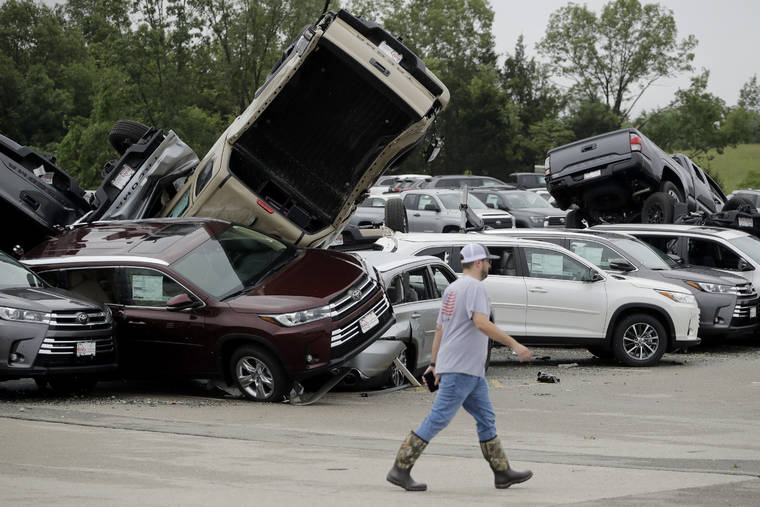
A worker walks past tornado-damaged Toyotas at a dealership in Jefferson City, Mo., Thursday, May 23, 2019, after a tornado tore though late Wednesday. (AP Photo/Charlie Riedel)
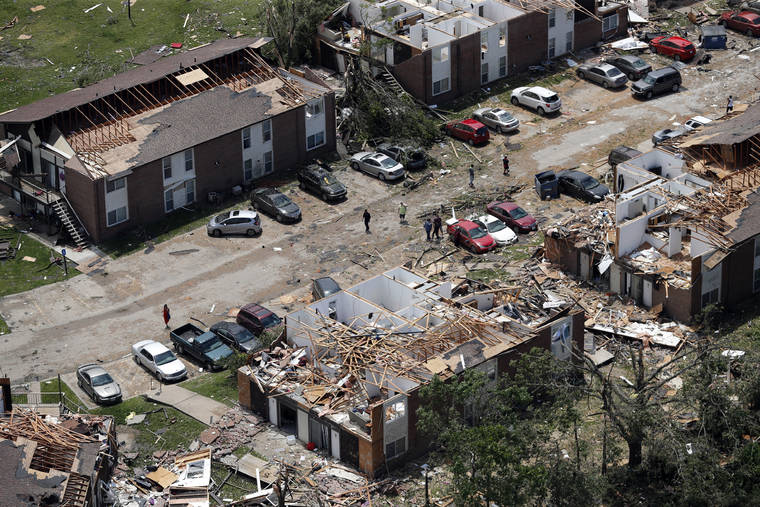
This aerial image shows severe storm damage in Jefferson City, Mo., Thursday, May 23, 2019, after a tornado hit overnight. A tornado tore apart buildings in Missouri’s capital city as part of an overnight outbreak of severe weather across the state. (AP Photo/Jeff Roberson)
JEFFERSON CITY, Mo. An outbreak of nasty storms spawned tornadoes that razed homes, flattened trees, tossed cars across a dealership lot and injured dozens of people in Missouris capital city and killed at least three others elsewhere in the state.
JEFFERSON CITY, Mo. — An outbreak of nasty storms spawned tornadoes that razed homes, flattened trees, tossed cars across a dealership lot and injured dozens of people in Missouri’s capital city and killed at least three others elsewhere in the state.
The National Weather Service confirmed that a large and destructive twister moved over Jefferson City shortly before midnight Wednesday.
The tornado cut a path about 3 miles long and a mile wide from the south end of Jefferson City north toward the Missouri River, said police Lt. David Williams. Emergency workers reported about two dozen injuries, Williams said, and around 100 of people were in shelters. Hospitals reported treating injuries such as cuts and bruises.
There were no immediate reports of any deaths or missing people in the capital city of about 40,000, but door-to-door checks were being done Thursday.
Many in Jefferson City considered themselves fortunate to survive.
David Surprenant watched the storm approach then rushed to join the rest of his family in the basement. By then, the windows had started shattering and the pressure dropped.
“It was just the eeriest sound ever, and it felt like it was taking your breath right out of you,” Surprenant, 34, said. He and his family were unharmed.
Kevin Riley operates a car dealership next to Surprenant’s home, where he sells Chevys and Toyotas. He figured that 98 percent of the approximately 750 vehicles on the lot were damaged.
Lincoln University President Jerald Woolfolk rode out the tornado in the basement of his official residence, and it may have saved his life. University spokeswoman Misty Young told the Jefferson City News-Tribune that the home, built 103 years ago, was so badly damaged it appeared to be uninhabitable.
Weather forecasters had been tracking the storm before it arrived in the capital city, and sirens first sounded in Jefferson City at 11:10 p.m. — about 30 minutes before the first property damage. Gov. Mike Parson credited the warning system in central Missouri for saving lives.
The three deaths happened more than 150 miles (240 kilometers) away near Golden City in Missouri’s southwestern corner.
Kenneth Harris, 86, and his 83-year-old wife, Opal, were found dead about 200 yards (180 meters) from their home, and Betty Berg, 56, was killed and her husband, Mark, seriously injured when their mobile home was destroyed, authorities said.
The National Weather Service said preliminary information indicates the tornado at Jefferson City was an EF-3, which typically carry winds up to 160 mph (260kph). Meteorologist Cory Rothstein said it’s possible that tornado had a 50-mile (80-kilometer) path and could have been on the ground for 80 minutes. Teams were surveying the path Thursday and trying to determine whether one or multiple tornadoes had touched down.
The severe weather moved in from Oklahoma, where rescuers struggled to pull people from high water. This week has seen several days of twisters and torrential rains in the Southern Plains and Midwest.
Kerry Ann Demetrius locked herself in the bathroom of her Jefferson City apartment as the storm approached.
“It sounded like stuff was being thrown around, everything was just banging together, and then it just went dead silent,” she said. She emerged to find the roof had been blown off her apartment building.
Austin Thomson, 25, was in the laundry room of his complex of two-story apartment buildings in Jefferson City when he saw sheets of rain coming down and a flagpole bend and slam to the ground in the wind. The windows broke, and he dove behind the washers and dryers.
The state high school track championships scheduled this weekend in the city were moved to different sites in central Missouri, after the Missouri State High School Activities Association issued a warning: “Do not travel to Jefferson City.”
Another natural disaster could be imminent in Jefferson City. Most of the city, including the tornado-ravaged section, sits on a bluff overlooking the south side of the Missouri River. But the swollen river is projected to top a levee on the north side of the river by Friday, potentially flooding the city’s airport, which already has been evacuated.
A tornado also skipped through the town of Eldon, population 4,900, about 30 miles (50 kilometers) outside Jefferson City, where it damaged the business district and “tore up several neighborhoods,” Miller County Emergency Management Director Mike Rayhart said.
He said several people were injured seriously enough to be sent to the hospital, but he did not have specifics.
A twister also caused damage and several injuries in the town of Carl Junction, not far from Joplin, on the eighth anniversary of the catastrophic tornado that killed 161 people in that city.
The severe weather was expected to push eastward Thursday, with forecasters saying parts of the Ohio Valley and the mid-Atlantic — including Baltimore and Pittsburgh — could see tornadoes, large hail and strong winds.
Storms and torrential rains have ravaged the Midwest, from Texas through Oklahoma, Kansas, Nebraska, Iowa, Missouri and Illinois, in the past few days.
Two barges carrying a total of about 3,800 pounds (1,700 kilograms) of fertilizer broke loose Thursday and floated down the swollen Arkansas River in Oklahoma, spreading alarm downstream as they hit a dam and sank. On Facebook, Webbers Falls, Oklahoma, warned the town’s 600 residents: “If the dam breaks, it will be catastrophic!! Leave now!!”
The barges had been floating out of control, on and off again, since Wednesday night near the town of 600, which was under a mandatory evacuation order due to flooding concerns. Aerial footage from the Oklahoma City television station KFOR showed the moment of impact shortly before noon Thursday. The Army Corps of Engineers was checking the dam for damage.
The Interstate 40 bridge and another span over the river were closed as a precaution. Over Memorial Day weekend in 2002, a barge struck the Interstate 40 bridge pier at Webbers Falls, causing part of the bridge to collapse into the Arkansas River. Fourteen people died after their vehicles plunged into the water.
Residents of northeastern Oklahoma were bracing for more possible flooding as the Army Corps of Engineers prepared to increase the rate of flow from a Keystone Dam, northwest of Tulsa, to the highest rate in at least 21 years. Officials said the increase will help lower the level of Keystone Lake, a popular recreational lake that’s more than 20 feet (6 meters) above normal.
But there was concern the increased flow could flood downstream communities along the Arkansas River. Tulsa police were evacuating neighborhoods near the river.
Missouri’s three tornado fatalities bring to seven the number of deaths from storms this week.
———
Associated Press writers Summer Ballentine in Jefferson City; Jill Bleed in Little Rock, Arkansas; John Hanna in Topeka, Kansas; Jim Salter in St. Louis; and Ken Miller and Tim Talley in Oklahoma City contributed to this report.

